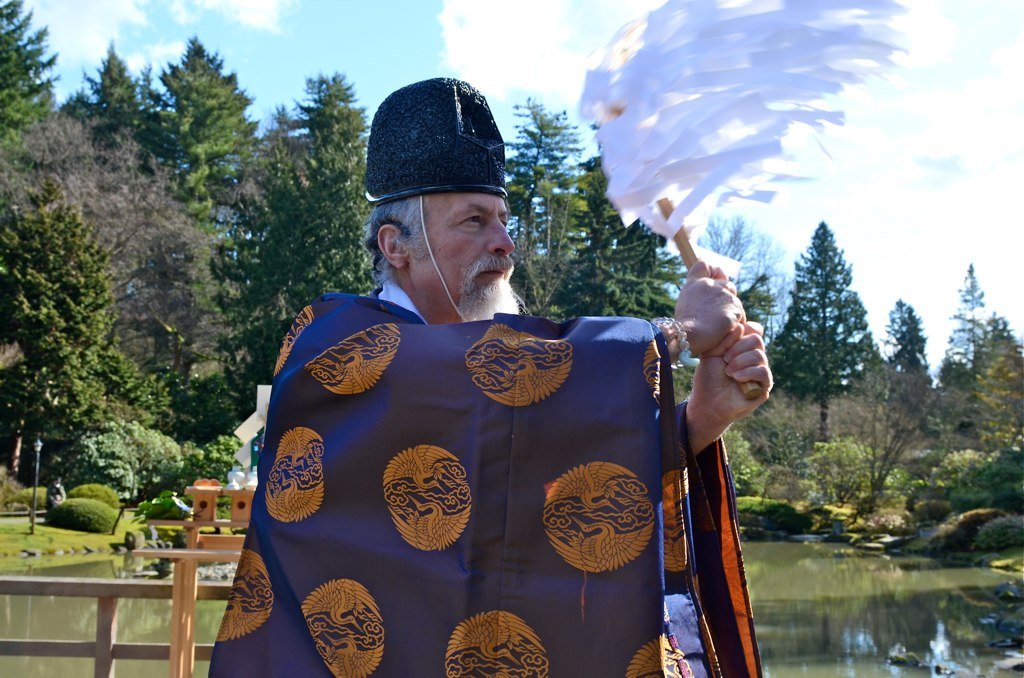Photo: Aurora Santiago
Come celebrate the 2023 Garden opening with us on Sunday, March 5th.
Schedule
10:00am – 2:00pm Recorded Shinto Blessing
Each year, we open the Garden with a traditional Shinto blessing ceremony to welcome ki (life energy) and provide good fortune for the season ahead. Reverend Koichi Barrish of Tsubaki Grand Shrine of America*, in Granite Falls, Washington, performed this year’s blessing at the shrine on February 16th, and we will show the recording of it in the Tateuchi Community Room, from 10 a.m. to 2 p.m.
11:30am – 12:30pm Shakuhachi (Bamboo Flute) Performance
The shakuhachi is a traditional Japanese bamboo flute developed in the 16th century. Shakuhachi player Hanz Araki* will bring us the sounds of spring with a performance in the Kinko-Ryu style on the Moon-Viewing Platform by the Garden pond, from 11:30 a.m. to 12:30 p.m. Developed 200 years ago during the Edo Period, Kinko-Ryu is one of the two main shakuhachi schools in Japan.
*In case of rain, Hanz Araki will play Shakuhachi at Roji garden under the eave at the Shoseian Tea House.
1:00pm and 2:00pm Guided Tours
Our Garden Guides* will lead two walking tours in the afternoon. Enhance your visit to the Garden by learning about its history, design, and spiritual principles. The 45-minute tours will begin at the ticket booth at 1 p.m. and 2 p.m. Free with admission.
Please let the ticket booth know that you'll be participating. The maximum number of each group will be twelve.
—
*Tsubaki Grand Shrine of America (from Wikipedia)
Tsubaki Grand Shrine of America is the first Shinto shrine built in the mainland United States after World War II. It was erected in 1986 in Stockton, California, and moved to its current location next to the Pilchuck River in Granite Falls, Washington, in 2001.
Photo from Tsubaki Grand Shrine of America
*Hanz Araki (Bio)
For six generations, the Araki family has carried the Kodō name and its perspective on the tradition of Kinko-Ryūshakuhachi. Named for his great-great grandfather, Hanzaburō—or Hanz as he’s commonly called—made his professional debut in 1988 in Shimonoseki, Japan, where he was given the name Baikyoku by his father, KodōAraki V. He attained the name Kodō at his father’s retirement ceremony in Tokyo in 2009.
Hanz performed and taught in Japan until 1992, when he returned to the United States and shifted his focus almost entirely to performing. Notable appearances include at the Newport Folk Festival, the Vancouver Folk Festival, Celtic Connections in Glasgow, Kiyomizu Temple in Kyoto, and the Gates Estate. He was a featured soloist for the Seattle Symphony “Celebrate Asia” concert in 2013.
More Information at arakikodo.com
Hanz Araki playing Shakuhachi at a Japanese garden.
message from our guides (Unit86)
It is an honor and a privilege for the members of Unit 86 to lead tours of the Garden. It is fun to meet guests from all over our county, state, and the world. Many visitors ask interesting questions and often bring insights of their own. Seattle Japanese Garden seems to offer a special experience to everyone, in all seasons of the year.
Picture from one of the public guide tours in the garden.




